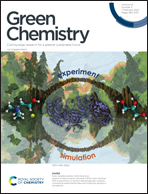Bio-based chitosan and cellulose ionic liquid gels: polymeric soft materials for the desulfurization of fuel†‡
Abstract
Desulfurization of fuel that avoids the introduction in the atmosphere of toxic sulfur volatile compounds, usually formed during combustion, is a viable strategy to reduce pollution. To find new efficient and eco-sustainable adsorbent materials, bio-based polymers such as chitosan (CS), cellulose (CE) and cellulose acetate (CEOAc) were dissolved in ionic liquids (ILs) to form ionic liquid gels (ILGs). Gelling and swelling ability, porosity, morphology, rheology and mechanical response were studied as a function of the polymer and ionic liquid (IL) used. The best performing gels were tested for fuel desulfurization using a fuel mimicking solution of thiophene (T), benzothiophene (BT) and dibenzothiophene (DBT) in hexane. T was the sulfur compound that adsorbed the fastest on gels, and the effect of different parameters affecting the adsorption process, such as the total concentration of sulfur compounds, volume of fuel, and the contact surface area of the gel, under static or dynamic conditions, was analyzed. Bio-based polymer ILGs proved to be promising adsorbents for fuel desulfurization allowing 84% removal efficiency to be reached for T and 60% for DBT and BT in a multistage apparatus. In addition, gels could be reused up to four times without any leaching of IL or polymer in fuel, proving to be competitive with other adsorbent materials currently used.



 Please wait while we load your content...
Please wait while we load your content...